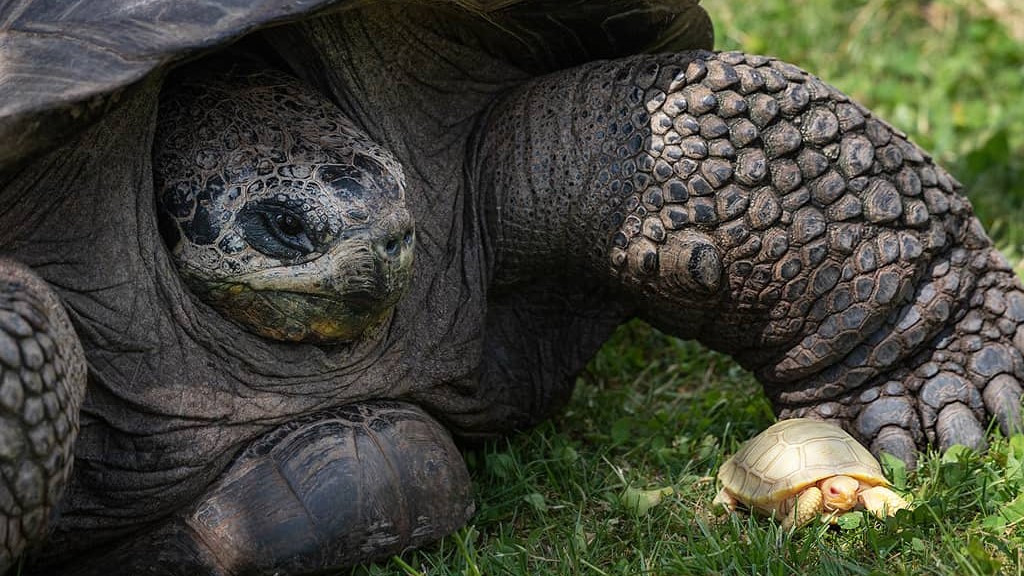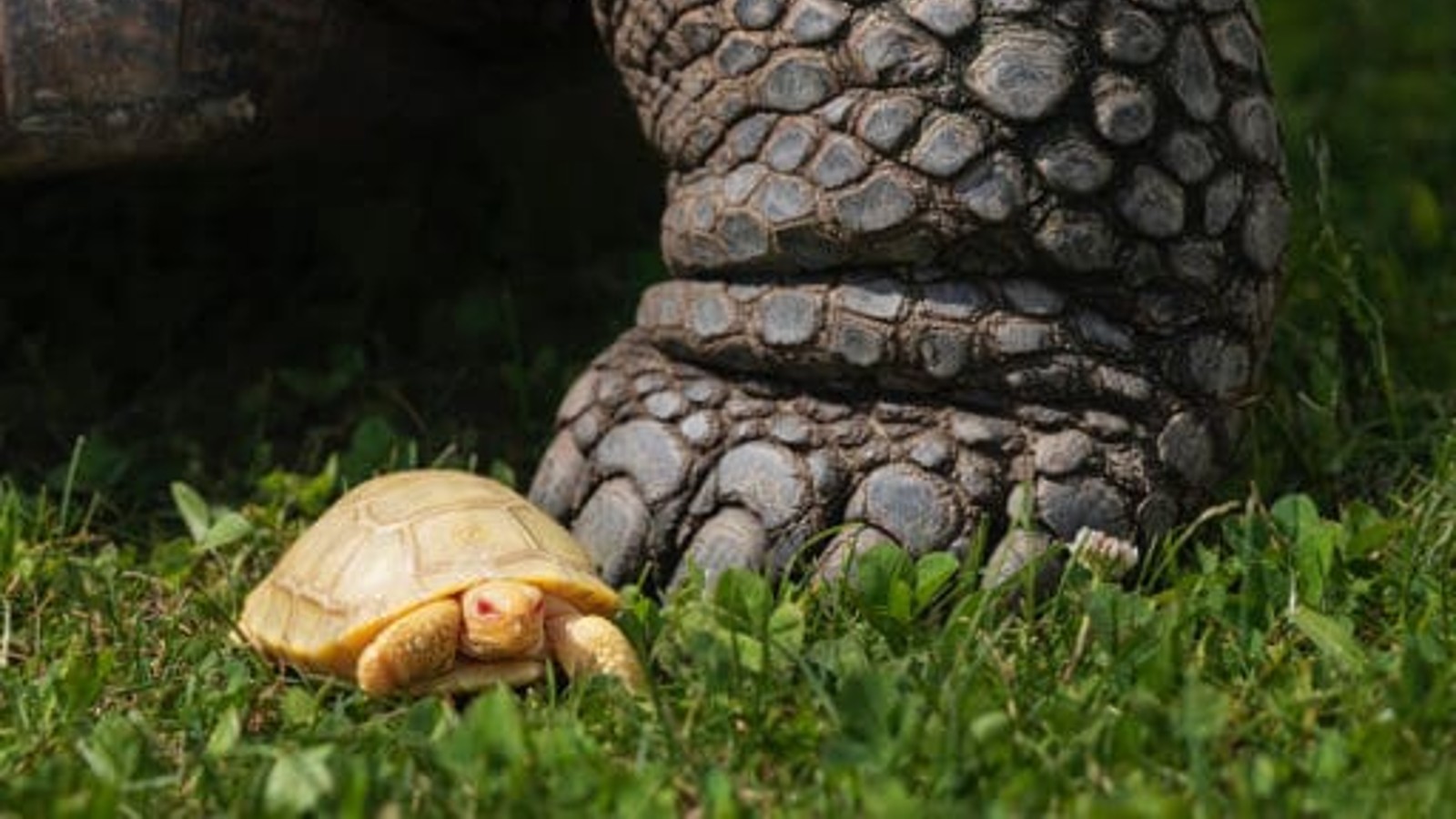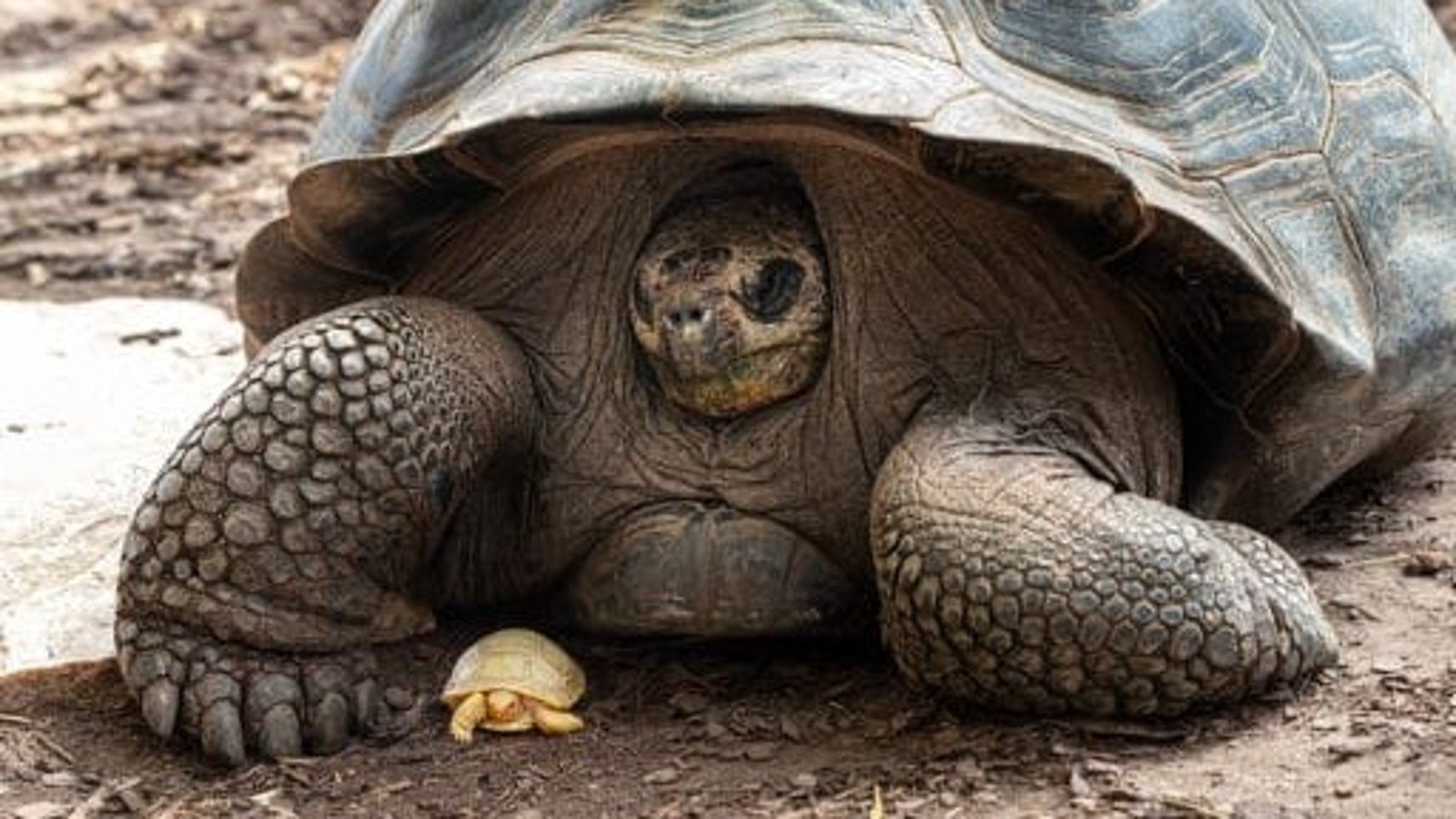Tiny white tortoise baby is the 'first of its kind'
The odds of an albino giant tortoise are 1 in 100,000.

An extremely rare white tortoise baby has just been revealed to the world for the very first time. The tiny, red-eyed reptile has pigmentless skin and a pale shell, caused by a genetic disorder known as albinism. Zoo keepers say the odds of an albino tortoise are 1 in 100,000.
The white tortoise is one of two Galápagos giant tortoises (Chelonoidis niger) that recently hatched at Tropiquarium, a zoo in Servion, Switzerland. The pair of eggs were laid by a 220-pound (100 kilograms) female on Feb. 11; the albino baby hatched on May 1 and its darker sibling emerged on May 5. The baby tortoises each weighed just 1.8 ounces (50 grams) at birth and were initially hand-reared by zookeepers in incubators, before rejoining their mother at the zoo on June 3, according to Reuters.
"We were surprised to discover an albino baby," zoo staff wrote in a statement. "This is the first time in the world that an albino Galápagos tortoise has been born and kept in captivity," and there are no documented cases in the wild, they added. The team also speculated that the birth of a white tortoise could be as much as five times rarer than the birth of an albino human, which is around 1 in 20,000 people, according to the National Organization for Albinism and Hypopigmentation, a nonprofit organization that provides information and resources about albinism to people in the U.S. and Canada.
Albino animals are unable to produce a skin pigment known as melanin, which is what gives color to skin, hair, eyes and feathers — and in this case, the tortoise's shell. Albino animals often appear to have red eyes because their eyes have no pigment, so they appear the same color as the blood vessels underneath the eyes' surface.
Related: 7 oddly colored animals that caught our eye in 2021
Albinism is a genetic condition, which means it is passed down from parents to offspring. However, it is a recessive trait, so both parents need to possess and pass on a copy of the gene. Because the parents usually only have one copy of the albino gene (unless they are also albino), they appear with the animal’s typical colors.
It is unclear how long the albino hatchling might survive. Galápagos giant tortoises are the largest tortoises on Earth and can live for more than 100 years in the wild. However, albinism can make animals more susceptible to damage from the sun's ultraviolet rays and prone to other health complications, such as reduced vision and hearing difficulties. It also makes animals that are normally darker colored more visible to predators. This means animals with albinism often don’t survive for very long and die before they can pass on their genes — which explains why the condition is so rare. But if they are cared for properly in captivity they can live relatively healthy lives.
Get the world’s most fascinating discoveries delivered straight to your inbox.




Breeding Galápagos giant tortoises in captivity can be challenging. The mating rituals of these enormous reptiles can be quite aggressive: Males repeatedly ram females' shells with their own and sometimes bite females' legs, before mounting them. The males also produce very loud and deep moaning sounds during sex, which helped inspire the roaring sounds of dragons from HBO's hit fantasy show "Game of Thrones."
Like a majority of reptiles, Galápagos giant tortoises’ gender is determined by the temperature at which the eggs are incubated. In this species, warmer conditions cause the tortoises to become female, and lower temperatures produce males, according to the San Diego Zoo. The genders of the new pair of hatchlings are uncertain because there are no physical differences between males and females at this age, according to Reuters.
Zoos are the only places where Galápagos giant tortoise hatchlings — albino or not — can be observed. In the wild, hatchlings seem to "disappear" until they are around five years old. Researchers aren't exactly sure where the babies go, but scientists suspect that the juvenile tortoises spend their first few years hiding in forest undergrowth to avoid their only natural predator: Galápagos hawks (Buteo galapagoensis), according to the Zoological Society of London (ZSL). Nobody is sure how the tiny tortoises spend these so-called lost years, but when they reemerge they are too large to be carried off by the predatory birds, ZSL says.
Captive breeding in zoos is a very important tool for conserving these massive tortoises, which have become scarce in the wild. Wild tortoise populations in Galápagos were severely impacted by early European explorers, whalers and naval crews, who hunted tortoises as a source of oil and food for long journeys across the seas. Scientists think there were once around 200,000 giant tortoises in the Galápagos Islands, which are named after the tortoises (the word "Galápagos" comes from an archaic Spanish word for "tortoise"), but there are now only around 15,000, according to the Galápagos Islands Trust.
Experts also believe that warmer temperatures caused by climate change could be skewing the gender ratio among tortoise hatchlings, which could impact future reproduction in the wild. (If more babies are born female, there will be fewer males to mate with, reducing genetic diversity in wild populations.)
Originally published on Live Science.

Harry is a U.K.-based senior staff writer at Live Science. He studied marine biology at the University of Exeter before training to become a journalist. He covers a wide range of topics including space exploration, planetary science, space weather, climate change, animal behavior and paleontology. His recent work on the solar maximum won "best space submission" at the 2024 Aerospace Media Awards and was shortlisted in the "top scoop" category at the NCTJ Awards for Excellence in 2023. He also writes Live Science's weekly Earth from space series.
